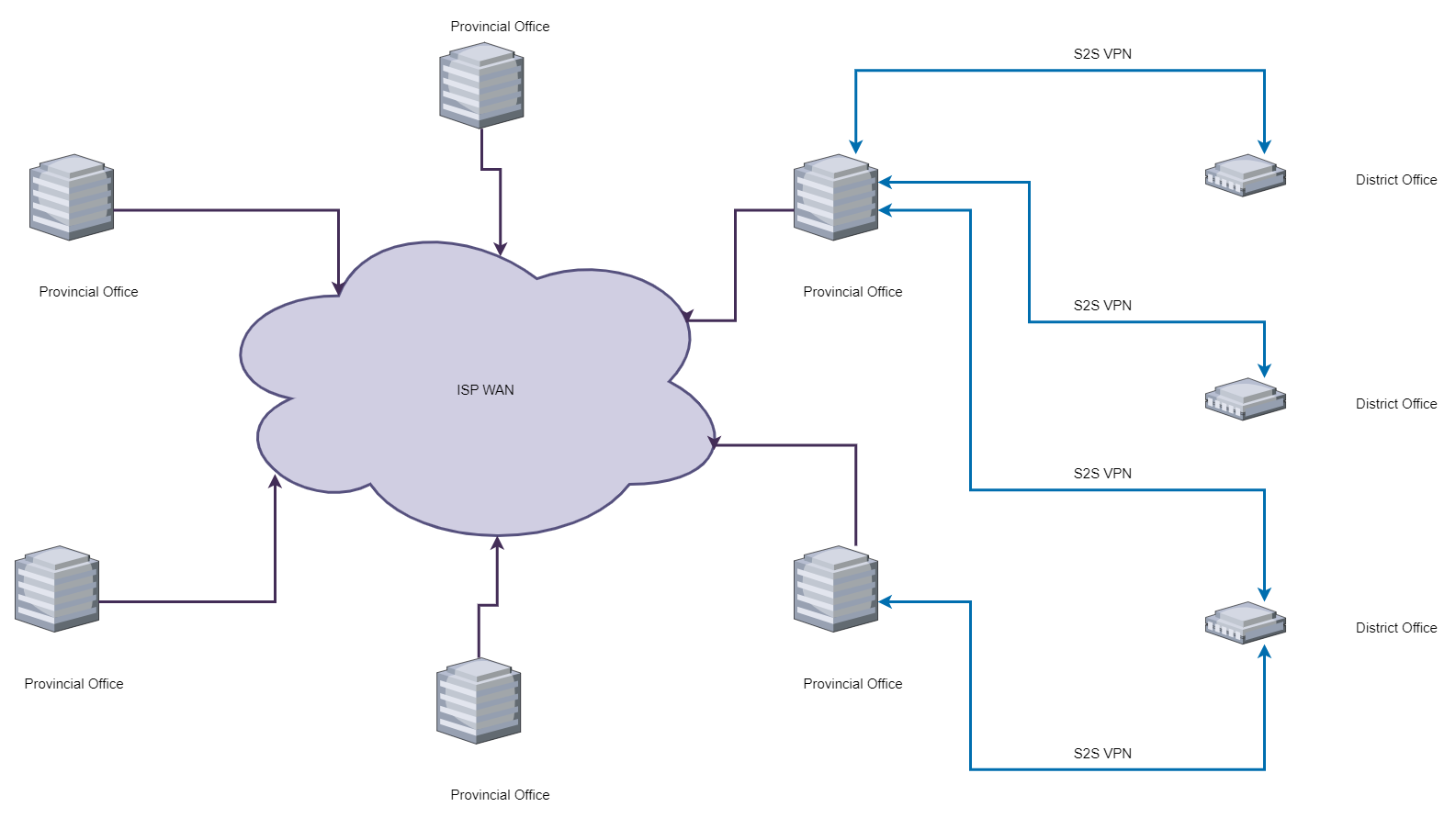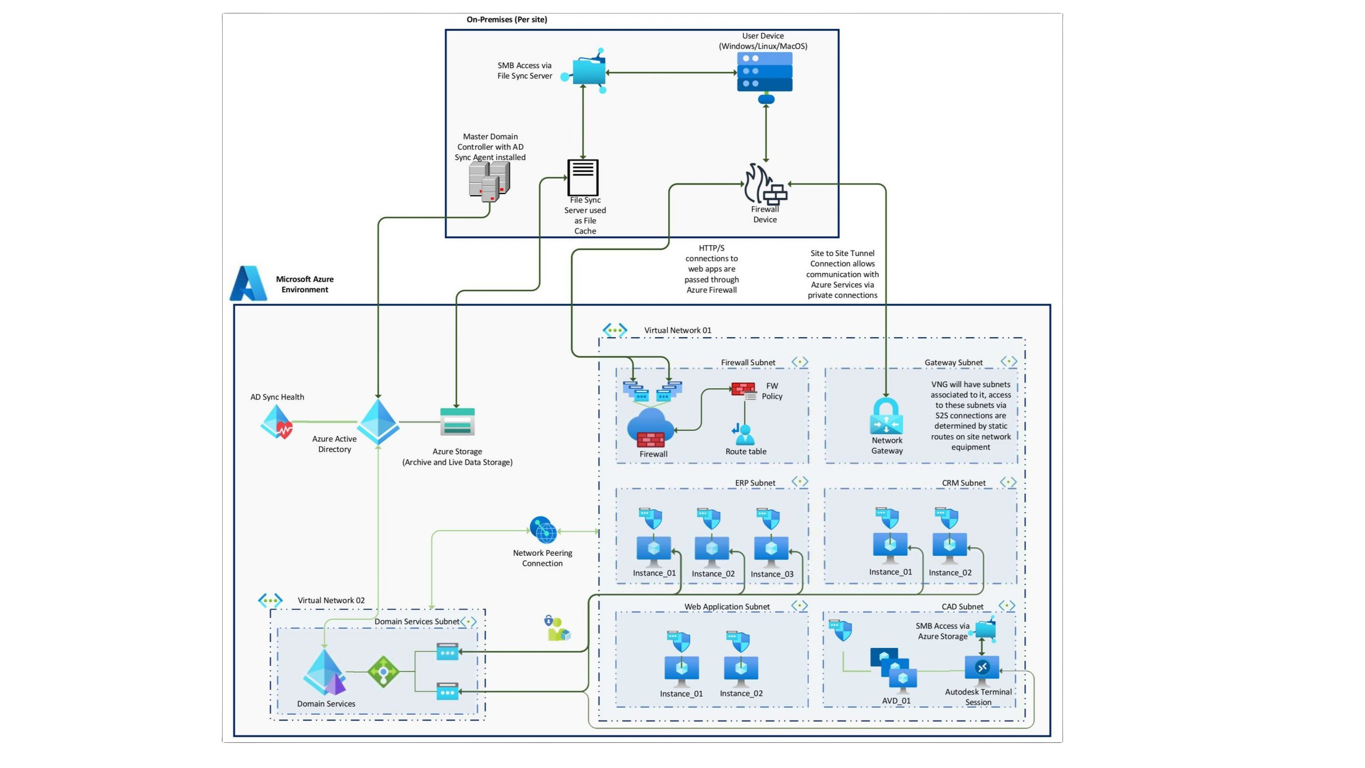Cloud Adoption for Multi-Site Environment: A Streamlined Approach to Collaboration
In today’s fast-paced digital environment, multi-site organizations face the challenge of unifying disparate systems while ensuring seamless data accessibility across geographically dispersed offices. Recently, I implemented a cloud adoption strategy for a multi-site enterprise, focused on enhancing collaboration, streamlining data management, and consolidating access control for ERP, CRM, CAD, and Web Application resources.
Here’s an in-depth look at the solution, which was designed to integrate with both existing systems and new cloud resources, ensuring robust performance and data accessibility for both provincial and district offices


Project Goals and Key Challenges
The primary aim of this project was to unify data and application resources across multiple offices. Each site previously functioned as an independent environment with local data, which posed challenges for cross-site collaboration, especially for resource-intensive applications like CAD. By migrating core business applications and data management to the cloud, I aimed to create a more cohesive, accessible, and manageable infrastructure that promotes efficient collaboration and enables real-time data access.
Given the extensive data requirements—averaging 10TB per site and reaching up to 50TB at the largest provincial office—this cloud adoption strategy required a carefully planned architecture to ensure scalability, accessibility, and performance.
Key Architectural Components
ERP, CRM, and Web Application Cloud Migration
The ERP, CRM, and Web Application resources were restructured to use Azure Virtual Machine Scale Sets. This service enables elastic scaling of virtual machines, providing the flexibility to adjust resources based on demand and ensuring high availability with optimized costs. By leveraging Azure’s scalability, each application now benefits from on-demand performance without unnecessary expense, making it a practical solution for moderate to high-traffic applications.
CAD Systems via Azure Virtual Desktop
CAD applications are notoriously resource-intensive, and to ensure that users in different locations could access CAD files efficiently, Azure Virtual Desktop (AVD) was implemented. Each CAD user now connects to a dedicated AVD instance, with historical data mounted directly via Azure Storage Services over SMB. This configuration provides the local-like performance CAD users need, irrespective of their location, while allowing centralized management and easy access to project files.
Hybrid Data Access with Azure File Sync
To bridge on-premises and cloud data, each provincial office was set up with an Azure File Sync Server, enabling hybrid access to archive and live data stored in Azure. District offices, in turn, connect to these File Sync Servers through Site-to-Site (S2S) VPN connections. This approach not only repurposes existing infrastructure but also provides local access to cloud-stored files, reducing latency and maintaining a seamless user experience.
Optimizing Network and Data Access
Site-to-Site VPN Connections
The network topology includes S2S VPN connections between provincial and district offices, ensuring secure and reliable data access across all sites.
This architecture centralizes access to critical files hosted in Azure and supports cross-site collaboration. It enables district offices to securely connect to provincial offices for shared data access, without necessitating separate cloud connections for each site.
Unified Storage and Archive Data Management
Given the substantial data volumes—up to 50TB at some sites—the solution incorporates Azure Storage Services for both live and archive data management.
This unified storage solution simplifies data access across all sites while supporting flexible retrieval and archival processes. The hybrid approach with Azure File Sync enables on-premises caching for rapid file access while maintaining long-term storage in the cloud.
Conclusion
This cloud adoption strategy for a multi-site environment delivers a robust, scalable, and cost-effective solution that meets the enterprise’s current and future data collaboration needs.
By centralizing and modernizing ERP, CRM, CAD, and Web App resources, the organization now benefits from improved access control, simplified management, and enhanced collaboration across locations.
The integration of Azure Virtual Machine Scale Sets and Azure Virtual Desktop ensures consistent performance across applications, while Azure File Sync provides a reliable bridge for on-premises access to cloud-stored data.
This architecture provides a foundation for continued growth, agility, and resilience, effectively transforming the way provincial and district offices interact and collaborate in a cloud-driven world.
